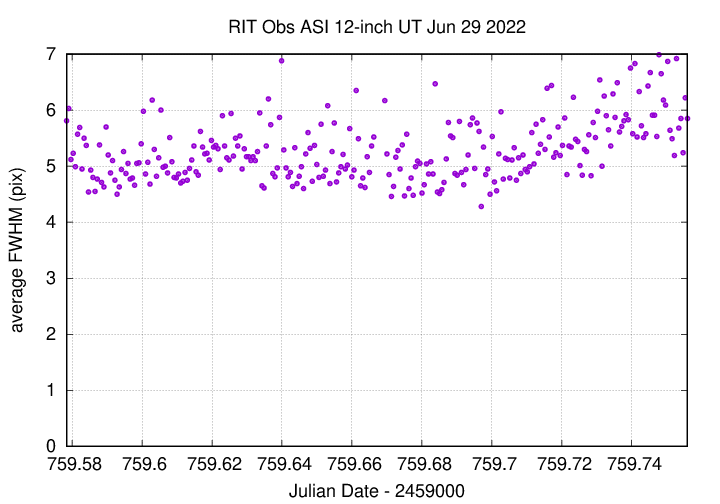
On the night of Jun 28/29, 2022, under good conditions, I acquired images of the outbursting cataclysmic variable star U Sco.
Tonight's observations were made on the 12-inch telescope with the ASI camera, exposure time 45 seconds. Results were nice, but at the end of my runs, the large airmass (at altitudes of 20 or even 16 degrees) causes the target to fade by perhaps an extra 0.1 mag.
In the rolloff structure, I moved the Y cable connecting to the Dec motor on the Astro-Physics 1200 GTO. Its new position should be much safer for it than the old one.
U Sco is a cataclysmic variable which only rarely is caught in an outburst. This one was first noticed at UT 2022 June 6.720 by Masayuki Moriyama. The star reached a peak brightness of about V = 8, but faded quite a bit by this evening; it is currently about V = 14.9.
The main setup was:
Notes from the night:
The object is located at
RA = 16:22:30.78 Dec = -17:52:42.8 (J2000)
A chart of the field is shown below. The size of the chart is about 42 x 30 arcminutes.

I've marked the location of several comparison stars as well, which appear on the AAVSO chart of comparison stars.
I'll use star "A" to shift my instrumental magnitudes to the V-band scale.
I took a photo of the finder TV's screen when pointing to this target; this could be a useful reference for the future:

The sky value shows a little bump due to clouds in the latter half.

The FWHM graph below shows a steep rise near the end, due to large airmass. The altitude was only 15 degrees, so airmass = 3.9! I think I should halt observations around 20 degrees at the most.

Using aperture photometry with a radius of 7 pixels in clear filter (binned 4x4, each pixel is 1.052 arcsec, so a radius of 7.4 arcsec), I measured the instrumental magnitudes of a number of reference stars and the target. Following the procedures outlined by Kent Honeycutt's article on inhomogeneous ensemble photometry, I used all stars available in each image to define a reference frame, and measured each star against this frame.
Sigma-vs-mag plots show that the floor was about 0.011 mag, not as nice as a few recent nights.

The change in zeropoint shows the effects of a brief set of clouds near the end.

The measurements show a decline of 0.5 mag, though the final 0.1 mag is probably due to differential extinction.

You can download my measurements below. A copy of the header of the file is shown to explain the format.
# Measurements of U_Sco made at RIT Obs, UT 2022 Jun 29, # in good conditions, # by Michael Richmond, # using Meade 12-inch LX200 and ASI 6200MM. # Exposures 45 seconds long, clear filter. # Tabulated times are midexposure (FITS header time - half exposure length) # and accurate only to +/- 1 second (??). # 'mag' is a differential magnitude based on ensemble photometry # using a circular aperture of radius 7 pix = 7.4 arcseconds. # which has been shifted so AAVSO 000-BBX-431 has mag=10.707 # which is its V-band magnitude according to AAVSO. # # UT_day JD HJD mag uncert Jun29.07963 2459759.57963 2459759.58469 14.496 0.028 Jun29.08027 2459759.58027 2459759.58533 14.503 0.028 Jun29.08090 2459759.58090 2459759.58596 14.553 0.027
We've had an Astro-Physics 1200 GTO mount in the roll-off structure for many years, and I've always worried about the safety of one of the cables. The motor-control cable splits into two pieces, and the one running to the Dec motor has been caught several times and slightly damaged. Last night, I examined images of other AP 1200 GTO mounts online, and noticed that they all ran this cable in a different manner than we did.
I wonder why none of us ever noticed that before....
So, I moved the cable to follow that example set by everyone else. It now looks like this:



I also removed the old power supply for the SBIG cameras from its place on the pier; it had been sitting there ever since 1999. It now lives in the closet with the two cameras it can power.
I'll take down all the cables on this mount, and re-arrange them for safety and convenience, later this week.
Last modified 6/28/2022 by MWR.